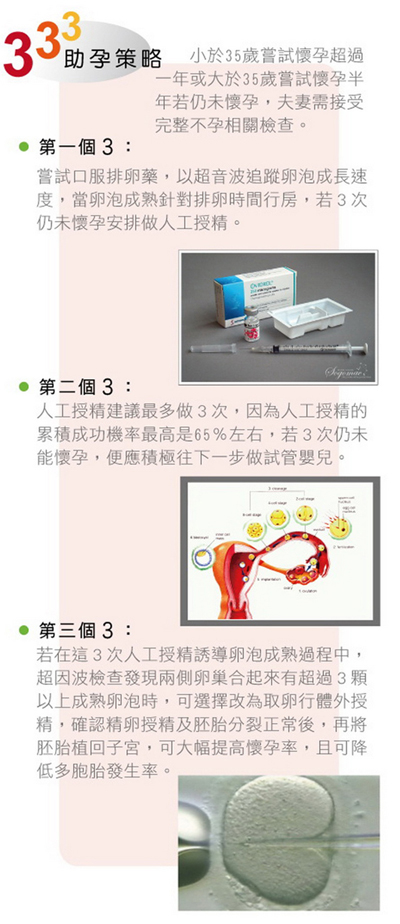2012-09-18
The golden period for infertility treatment.
Author: HSIEN-AN PAN MD.PHD. In 2010, Taiwan was already ranked last in terms of global fertility rate, with the fertility rate declining rapidly. The National Health Bureau of the Department of Health in Taiwan has projected that the total population of Taiwan will no longer increase and may even experience negative growth in 30 years. This is a significant issue that cannot be underestimated in terms of national competitiveness.
In 2010, Taiwan was already ranked last in terms of global fertility rate, with the fertility rate declining rapidly. The National Health Bureau of the Department of Health in Taiwan has projected that the total population of Taiwan will no longer increase and may even experience negative growth in 30 years. This is a significant issue that cannot be underestimated in terms of national competitiveness.
It may be too presumptuous to claim that modern people are unwilling to have children. The main reason why young people are choosing not to marry or have children is often due to economic concerns. To address the declining fertility rate, improving the education system and reducing the cost of education are considered the most effective measures by the public. The Department of Health conducted a survey on the attitudes towards marriage and childbirth among the Taiwanese population and found that people are not unwilling to get married; rather, economic circumstances and finding a suitable partner are the limiting factors. Among those who are already married and have one child, their reluctance to have another child is also rooted in economic concerns. This highlights that economic factors related to raising and educating children are the primary reasons for the low fertility rate. Therefore, alleviating the financial burden of child-rearing will be a key focus of population policies. However, it is worth noting that there are still approximately 8,000 cases of assisted reproductive technology (ART) procedures, including in vitro fertilization (IVF), taking place in Taiwan each year, with around 20,000 individuals seeking assistance for artificial conception. This indicates that although Taiwan has a low fertility rate on a global scale, many couples still desire to have children but lack the financial means to do so.
In general, the optimal pregnancy period for women is considered to be between the ages of 25 and 35. However, the current social situation is witnessing a rise in the number of women marrying at a later age. After marriage, couples often wish to enjoy their time together as a couple, and factors such as economic concerns and the unfavorable parenting environment in Taiwan lead many individuals to repeatedly postpone their plans for childbirth. When they eventually decide to conceive, they may face difficulties in getting pregnant. The main reason behind this is the decline in ovarian function, which starts at around 35 years of age and rapidly decreases after the age of 38. The decline in egg quality not only makes it difficult to conceive but also increases the risk of chromosomal abnormalities associated with advanced maternal age.
There is a misconception among the public regarding fertility treatment. Many people mistakenly believe that a woman's fertility significantly declines after the age of 50 and that the success rate of in vitro fertilization (IVF) at the age of 40 is around 50%. In reality, 35 years of age is considered a turning point for female fertility. The pregnancy rate for artificial reproductive techniques before the age of 35 is approximately 45%, but it drops to only 15% for women over 40.
There is a misconception among the public regarding fertility treatment. Many people mistakenly believe that a woman's fertility significantly declines after the age of 50 and that the success rate of in vitro fertilization (IVF) at the age of 40 is around 50%. In reality, 35 years of age is considered a turning point for female fertility. The pregnancy rate for artificial reproductive techniques before the age of 35 is approximately 45%, but it drops to only 15% for women over 40.
Infertility can be defined based on age criteria: For women under the age of 35, if they have regular unprotected sexual intercourse 2 to 3 times a week for a year without achieving pregnancy, it is recommended for both the man and woman to undergo medical evaluations. For women over the age of 35, if they have been trying to conceive for six months without success, it is advisable for both partners to seek medical examination. If both partners' fertility functions are normal, the "333 fertility strategy" can be considered: The first "3" refers to using oral ovulation-inducing medication for three menstrual cycles. If pregnancy is not achieved, the next step is the second "3," which involves three cycles of artificial insemination. It is generally recommended not to exceed three cycles of artificial insemination, as the cumulative success rate for artificial insemination is around 65%. If pregnancy is still not achieved after three cycles, it is advisable to proceed to the next step, which is in vitro fertilization (IVF), in order to avoid wasting time and experiencing physical and psychological stress. The third "3" in the strategy refers to the consideration of IVF when there are three or more mature follicles in the ovaries during the assisted reproductive plan with artificial insemination.
Dr. Hsien-An Pan, from the An-An Maternity and IVF Center, explains the rationale behind the second "3" in the 333 fertility strategy (artificial insemination). During this stage, which involves inducing ovulation, if there are more than three mature follicles, it is recommended to proceed with egg retrieval for in vitro fertilization (IVF). This approach offers several advantages, including reducing the likelihood of multiple pregnancies and lowering costs. Moreover, it can significantly increase the chances of pregnancy and, most importantly, save unnecessary time and steps, allowing couples to seize the golden opportunity and enhance their chances of conceiving.




